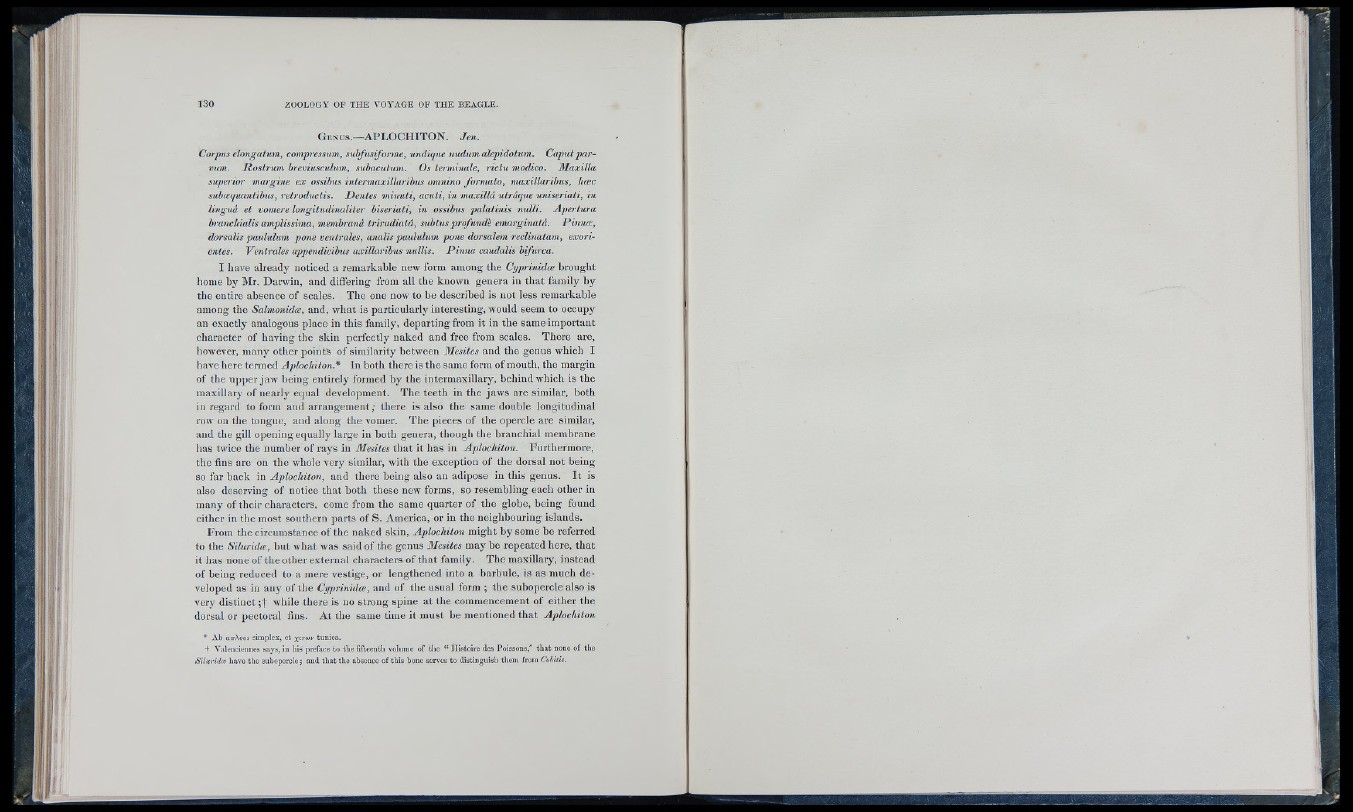
G e n u s .— APLOCHITON. Jen.
Cox'pus eloxig'atxim, compressum, suhfusiforme, xmdique nudum alepidotum. Caput parvum.
Rostrum brexñuscxiluni, suhacutxim. Os termínale, rictu modico. 3Iaxilla
supei'ior margine ex ossihis intermaxillaribus omnino fox'xnato, maxillax-ibus, hcBC
subeequantibxis, I'etroductis. Denies minuti, acxiti, in maxilU uUZique uniseriati, in
lingua et vomere longitudinaliter biseriati, in ossibus palatinis nulli. Apertura
brancliialis amplissima, membrand triradiald, subtus profundh emarginatd. Pinnee,
dorsalis paxdulum pone ventrales, analis paululum pone dorsalem reclviatam, exori-
entes. Ventrales appendicibus axillaribxis nullis. Pmna caudalis bifurca.
I have already noticed a remarkable new form among the Cyprinidce brought
home by Mr. Darwin, and diftering from all the known genera in that family by
the entire absence of scales. The one now to be described is not less remarkable
among the Salmónida, and, what is particularly interesting, would seem to occupy
an exactly analogous place in this family, departing from it in the same important
character of having the skin perfectly naked and free from scales. There are,
however, many other pointfe of similarity between 3Iesites and the genus which I
have here termed Aplochiton.* In both there is the same form of mouth, the margin
of the upper jaw being entirely formed by the intermaxillary, behind which is the
maxillary of nearly equal development. The teeth in the jaws are similar, both
in regard to form and arrangement,- there is also the same double longitudinal
row on the tongue, and along the vomer. The pieces of the opercle are similar,
and the gill opening equally large in both genera, though the branchial membrane
has twice the number of rays in Jlesites that it has in Aplochiton. Furthermore,
the fins are on the whole very similar, with the exception of the dorsal not being
so far back in Aplochiton, and there being also an adipose in this genus. It is
also deserving of notice that both these new forms, so resembling each other in
many of their characters, come from the same quarter of the globe, being found
either in the most southern parts of S. America, or in the neighbouring islands.
From the circumstance of the naked skin, Aplochiton might by some be referred
to the SiluridcE, but what was said of the genus 3Iesites may be repeated here, that
it has none of the other external characters of that family. The maxillary, instead
of being reduced to a mere vestige, or lengthened into a barbule, is as much developed
as in any of the Cyprinidce, and of the usual form ; the subopercle also is
very distinct ;t while there is no strong spine at the commencement of either tlie
dorsal or pectoral fins. At the same time it must be mentioned that Aplochiton
• Ab airXoos simplex, et \ ltuiv tunica.
t Valenciennes says, in his preface to the fifteenth volume of the “ Histoire des Poissons,” that none of tlie
Siluridw have the subopercle ; aud that the absence of this bone serves to distinguish them from C'olids.